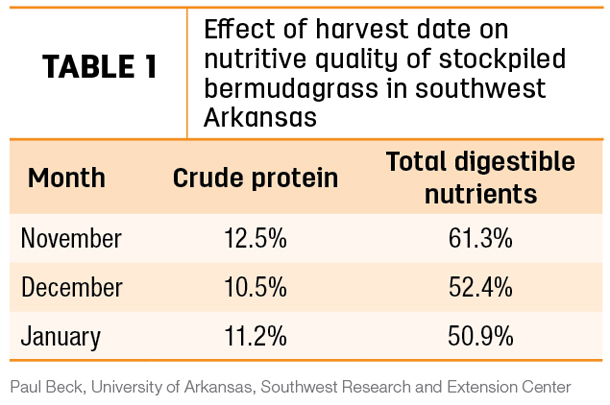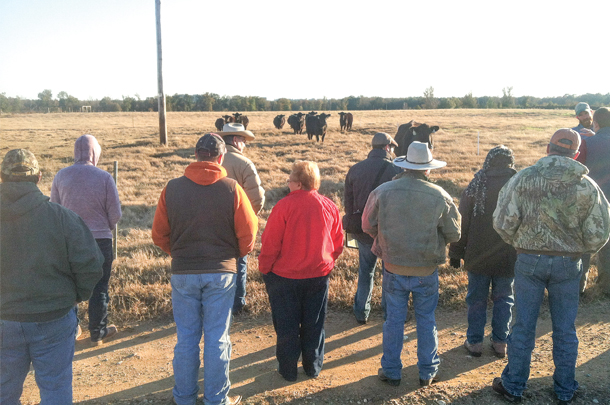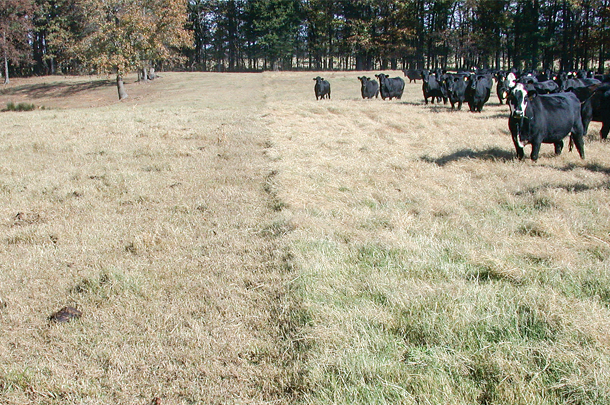Grazing stockpiled forages reduces the need for hay feeding during the fall and winter, thereby reducing input costs.
Why not graze that last cutting of bermudagrass and save a little money? There are several factors that make this an attractive addition to a grazing management strategy.
In the fall, many regions have ideal growing conditions for growing bermudagrass with more rain and milder temperatures, which contribute to reduced fiber content and more high-quality leaf area in the plant, thereby improving forage quality.
In the Southeastern states, it’s not uncommon to yield over a ton of forage per acre in the fall, with fall forage yield reaching double or triple that under favorable conditions and management.
Savings through stockpiling
Stockpiling is a management technique in which forage mass is accumulated through late summer and early fall for subsequent grazing in late fall and early winter. Research in Arkansas shows that producers in Southern states can stockpile bermudagrass and produce significant forage yield in late summer that can be grazed effectively during late fall through mid-December, reducing the need for hay feeding.

Dormant bermudagrass is of good quality in the fall, many times exceeding the quality of hay produced, and can be as high as 11 percent crude protein (CP) up to early January, well above the requirement for dry cows.
However, Paul Beck, professor with the University of Arkansas says, “It is important to remember the quality of stockpiled forage is declining every day following a frost, and the rate at which that decline occurs varies and depends greatly on the weather.”
Bermudagrass grows best from 85ºF to 95ºF and declines dramatically when night temperatures drop below 60ºF. Stockpiling should begin in August to produce enough standing forage.
Existing forage residue needs to be removed to a stubble height of 2 to 3 inches by mowing or cutting for hay in early August. Cattle should be excluded from pastures and 50 to 60 pounds of nitrogen applied per acre. Defer grazing until late October to allow forage to accumulate.
Improved grazing practices will extend the availability of stockpiled forages. Strip grazing prevents excessive trampling and waste. A single-wire electric fence can be used to portion off the desired amount of forage, depending on how often you want to move the fence.
Roy Gene Britt, a cattleman from southwest Arkansas, has utilized rotational grazing for 20 years and tried stockpiling bermudagrass last fall with good results.
As a pilot test, he stockpiled 80 acres, 40 of which he grazed for two weeks with 240 mature cows and calves. He says, “I don’t do it by the book; the way my operation runs, by the book doesn’t work, so I do what works for me.”
Britt baled some of the stockpiled grass because he was concerned about the quality and his hay supply, but he says, “It cost me more to bale it than to graze it.” In this pilot test, stockpiling 40 acres afforded him 168 grazing days per acre.
A look at the studies
A demonstration conducted in 1998 by the Noble Foundation produced 4,261 pounds of forage per acre. Sixty pounds of nitrogen were applied to 24 acres, and the first killing freeze occurred late in December and allowed strip grazing from mid-November through mid-January.
In on-farm demonstrations conducted from 2002-2006 by the University of Arkansas Division of Agriculture, stockpiled bermudagrass sampled in October was 23.8 percent CP and 81 percent total digestible nutrients (TDN). Samples taken in February were 6.5 percent CP and 48.8 percent TDN.
During that four-year period, 97 percent of stockpiled bermudagrass samples met the nutrient requirements of CP for dry cows, 82 percent met the requirements for lactating cows, 99 percent met the TDN requirements for dry cows, and 71 percent of samples met the TDN requirements for lactating cows.
The University of Arkansas conducted another long-term demonstration, “Reducing Winter Feed Costs,” wherein 90 on-farm stockpiled forage demonstrations were conducted, and the average forage production ranged from 68 to 93 animal unit grazing days per acre – and some farms were able to reach 100 to 200 animal unit grazing days per acre.

In these demonstrations, strip grazing doubled the number of animal unit grazing days per acre compared with continuous grazing.
Oklahoma State University research shows stockpiled bermudagrass produced an average of 2,750 pounds per acre of forage. Strip grazing typically has a grazing harvest efficiency from 70 to 80 percent, but to ensure desired animal performance, OSU recommends a harvest efficiency of 60 percent.
For planning purposes, you should assume cattle will utilize 60 percent of the available forage and not force them to graze the mature forage too closely. Ryan Reuter, animal science professor at OSU, says, “You need to allow cows to have grazing selectivity.
They will select the higher-quality leafy area of the plant and will perform better. If you push the harvest efficiency to 80 to 90 percent, essentially making them eat every part of the plant, you remove the selectivity, and they have to eat the lower-quality portion and animal performance will suffer.”
In most situations, protein supplementation isn’t necessary for stockpiled bermudagrass. As quality of the standing cured forage decreases, supplementation of energy sources may be necessary to maintain animal performance and body condition.
Oklahoma State University and Noble Foundation also compared stocker-calf performance on bermudagrass hay to stockpiled bermudagrass for three years, concluding that stocker producers could expect similar performance of calves grazing fertilized stockpiled bermudagrass to calves fed bermudagrass hay.
The important thing to consider is the declining quality of the stockpile over time, monitor calf performance and supplement accordingly.
Think ‘one season ahead’
A common concern that may prevent producers from trying to stockpile bermudagrass is the mistaken perception that nitrogen fertilizer applied during late summer will volatilize and be lost. If ammonium nitrate is used, losses will be minimal.
Urea fertilizer, on the other hand, can volatilize, usually losing less than 20 percent if rainfall doesn’t occur soon after application.

According to John Jennings, professor at the University of Arkansas, “When planning a grazing strategy, you have to think at least one season ahead.” He recommends the following steps for managing stockpiled bermudagrass:
- Remove existing forage residue from late July to early August, leaving a stubble of only 2 to 3 inches.
- Fertilize with 50 to 60 pounds of nitrogen per acre in early to late August (depending on location).
- Defer grazing until late October to allow for forage accumulation.
- Strip or rotationally graze to prevent waste and extend the grazing period.
- Ideal grazing period is October - December most years.
Stockpiled bermudagrass yields will vary depending on the weather. In favorable years, with proper management producers can expect 4,000 pounds of forage yield.
It is important to monitor animal performance, allow for grazing selectivity and, of course, have a back-up plan. ![]()
PHOTO 1: Cows strip grazing stockpiled bermudagrass early in the fall.
PHOTO 2: Brandon Stuart, University of Arkansas Southwest Research and Extension Center, explains to a group of producers a stockpiled bermudagrass demonstration at a field day in Hope, Arkansas.
PHOTO 3: Comparison of the fresh allotment of stockpiled bermudagrass to the previously grazed portion. Photo provided by John Jennings, University of Arkansas.

-
Melissa Beck
- Freelance Writer
- Prescott, Arkansas
- Email Melissa Beck








